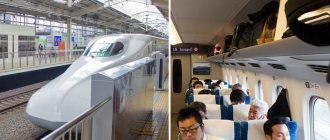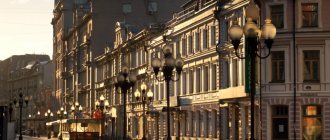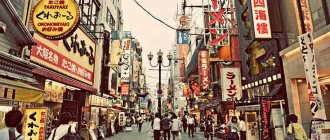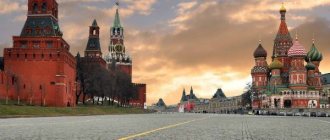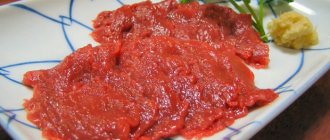Japan is one of the most developed countries in the world. This state has its own thousand-year history, traditions, and unique culture. The country is located in East Asia on the Japanese archipelago, consisting of 6,852 islands. The largest islands of the country:
- Hokkaido
- Honshu
- Shikoku
- Kyushu
Despite the relatively small area, the country's population density is high. Japan has a population of 126,225,000. The state is also called the Land of the Rising Sun. The Japanese themselves often call their homeland Nihon (homeland of the sun). In 1945, the country was attacked with nuclear weapons by the United States. The tragedy claimed thousands of lives; today Japan is the only state in the world against which such weapons were used. But it was able to recover, building a strong economy over the years, and today ranks 10th in terms of living standards.
Only here to this day the ruler is called the emperor. Modern Japanese are very successful not only in the economy, but also in science, biomedicine, robotics, and high technology. Japanese scientists have been awarded various prestigious awards, the Nobel Prize, and the Fields Prize.
The Japanese care about the environment and carefully preserve the country's rich heritage, represented by castles, temples, palaces, and monuments. All of them have survived to this day almost in their original form. More than a million tourists visit the state every year.
TOP 10 most beautiful cities in Japan
- Osaka is an interesting tourist metropolis.
- Kyoto is the guardian of the country's cultural heritage.
- Nara is the oldest Japanese city.
- Ise is a popular home for Ise-Jingu Shrine.
- Tokyo is an ultra-modern metropolis.
- Matsumoto - the charm of historical places.
- Sapporo is a famous ski resort.
- Kanazawa is a fortified city in Japan.
- Nagano is the most mountainous prefecture on the island of Honshu.
- Kobe - the exotic atmosphere of Japan.
Kyoto
The former capital of Japan is steeped in history and is considered the most beautiful city in the country. Arriving here, tourists marvel at the abundance of fantastic historical sites and the richness of Japanese heritage.
Kyoto is the spiritual and cultural capital of Japan. There are more than two thousand temples and monasteries, as well as numerous rock gardens, winding cobbled alleys, fantastic palaces, tourist villas and traditional tea establishments. The city has a variety of bars, atmospheric cafes and world-class restaurants.
Kyoto is one of the best places to see cherry trees, which create a romantic atmosphere. It's an amazing combination of modern and traditional influences.
Osaka is a national center for entertainment and theater
In terms of the size of Japanese cities, Osaka ranks third. The metropolis is full of life, energy, where there is everything you need for a great time. The city is more permeated with Japanese culture than the capital; the atmosphere and character of Japan are very noticeable. The residents here, according to tourists, are friendly, spontaneous, and sincere. They are famous throughout the country for their great love of food and business acumen. The culinary center of the country is located here; guests can try a variety of dishes, national delicacies, restaurant and street food.
There are many attractions, Osaka is called the Venice of Japan; the metropolis has many lakes, streams, canals, bridges in various architectural styles. Ancient temples have been preserved, which are located next to modern skyscrapers and amusement parks. Must-see attractions in Osaka:
- Bunraku National Theatre;
- national art museum;
- ramen museum (instant noodle museum);
- chess park;
- Osaka Kaiyukan Aquarium;
- Japanese Disneyland;
- Umeda Sky Building;
- science museum;
- Organic Building;
- Sumiyoshi-taisha Temple;
- kingdom of crabs;
- Poisonous fugu fish restaurant.
Yokohama
Even though Yokohama is less than half an hour from Tokyo, the city certainly has its own personality. It is a fairly large city in Japan and is the second largest city. Yokohama is nestled in a beautiful bay that creates an unforgettable landscape. In this city you will find houses built in different architectural styles and taste delicious national cuisine.
Kyoto is synonymous with traditional Japanese culture
For more than a thousand years, the historical center of the country was concentrated here. Kyoto was the capital of Japan from 794 to 1869. The metropolis is located in the center of the island of Honshu, the old name of the city is Heian. Kyoto is founded in the form of an elongated rectangle; the layout of streets, blocks, and squares is regular and symmetrical. World famous poets, artists, and writers were born here. Many ancient buildings and places of cultural heritage have been preserved in Kyoto, in particular the Imperial Palace, which can be visited as part of a tour. Some city streets are listed as World Heritage Sites.
The national center of traditional practices of chado (tea ceremony) and ikebana (flower arranging) is located here. This is the birthplace of kabuki, a leading center of calligraphy, sculpture, and painting.
It is definitely worth visiting such historically memorable places as the Kyoto Gosho Imperial Palace, where the coronation ceremony of the new emperor of Japan, rituals, important state ceremonies are held, the Kyoto Imperial Residence, the imperial villas of Shugakuin, Katsura. They can only be visited by people over 18 years of age; they must present a passport at the entrance.
Other noteworthy places in the city:
- Nijo Castle;
- Ryoan-Ji Temple;
- Sanjusangendo Temple;
- Fushimi Inari Taisha Shrine;
- bamboo forest;
- Diakaku-ji Temple;
- Gion district;
- philosophical path;
- Buddhist Temple of Pure Water;
- Silver Pavilion;
- Golden Pavilion;
- Kyoto Gardens.
Sights of Japan. 11 best
Sights of Japan. 11 best
Many first-time visitors to Japan are often surprised to learn that this relatively small Asian country, as one of the most industrialized countries in the world, also boasts a rich and fascinating history dating back thousands of years.
Indeed, long before many of Europe's most impressive cathedrals were built, Japanese Shinto and Buddhist temples were already well known and attracted pilgrims and patrons due to their often elaborate design and decoration.
At the same time, the country was already honing the skills that would put it on the path to wealth, from fine porcelain and ceramics to textiles such as silk. Much of this rich tradition has been preserved (or rebuilt) despite war and natural destruction, and a visit to Japan is an unforgettable experience.
Discover the best places to visit with our list of the top tourist attractions in Japan.
Fujiyama.
Without a doubt, Japan's most recognizable landmark, the majestic Mount Fuji (Fuji-san) is also the country's highest mountain peak, rising 3,776 meters above the largely flat landscape to the south and east and high enough to be visible from Tokyo more than 100 kilometers.
Mount Fuji has been celebrated in art and literature for centuries and is now considered such an important landmark that UNESCO recognized it as having world cultural significance in 2013.
Part of Fuji-Hakone-Izu National Park
More than a million people make a pilgrimage to Mount Fuji every summer, culminating in watching the sunrise from the summit.
While some still choose to start their climb from the very base of the mountain, most climbers now start halfway up, at Station 5, resulting in a more manageable six-hour climb. Of course, for many, simply looking at a mountain in the distance or from the comfort of a high-speed train is enough to say, “been there, done that.”
Personally, we ourselves did not climb the mountain at all. We saw it from afar. So we can say that too. Was there. Did this.
2 Imperial Palace in Tokyo.
Imperial Palace
With its beautiful 17th-century parks, surrounded by walls and moats, it is Tokyo's most famous landmark.
However, one should not forget the fact that most of the palace is closed to the public (it is still used by the Imperial Family), but there is enough beauty to enjoy the views.
In addition to many wonderful views of the palace from numerous points in the surrounding park - including the famous Nijubashi Bridge
or “double bridge,” named for its reflection in the water, visitors are allowed
to visit the East Higashi-Gyen Garden
and other areas. which are open to the public.
Tourists visiting Tokyo should visit Ginza
, home to
the Kabuki-za Theater
with its Kabuki performances, as well as
the Shimbashi Enbujo Theater
with traditional
Azuma-odori dances
and bunraku performances.
Personally, I highly recommend visiting the famous crossroads in the center. The busiest pedestrian crossing in the world.
3 Hiroshima Peace Memorial Park
While little will be said here about the horrors of the atomic bombing of Hiroshima in August 1945, much can be said about the incredible efforts made by this vibrant city to commemorate the many victims of the world's first nuclear attack, and perhaps more importantly, the symbol of lasting peace it has become Hiroshima.
More than a million people visit it every year, many of whom are abroad. Hiroshima Peace Memorial Park (Hiroshima Heiwa Kinen Ken) is located at the epicenter of the atomic explosion in a once-bustling part of the city and includes a number of important monuments, memorials and museums related to the events of that fateful day.
In addition to the grounds and gardens with their colorful cherry blossoms, highlights of the park include the Peace Memorial Museum
with its many exhibits dealing with the issue of world peace and
the memorial cenotaph and flame of peace
, as well as
the Atomic Bomb Dome
, the ruins of the administration building lying at the center of the explosion.
4 Historical Kyoto
One of Japan's most visited cities, beautiful Kyoto - one of the few cities in the country to have been spared the devastation of World War II - attracts more than 10 million visitors each year to explore its beautiful old streets and architecture, much of which remains unchanged since imperial times. family who settled here more than 1000 years ago.
Even then, the city was Japan's most important cultural center, with a legacy of numerous museums and art galleries, each containing important sculptures, paintings and other forms of art.
Highlights of Buddhist-influenced architecture in Kyoto include many well-preserved temples, 30 of which are still in use, and important structures such as the Golden Pavilion
14th century (Kinkaku-ji), famous for its exquisite gilded cladding. ,
Be sure to also visit Nijo Castle, a fortress
17th century, retaining its original walls, towers and moat; its beautiful gates; and his palace with a beautiful interior.
It is also worth visiting the original Imperial Palace in
Kyoto (Kyoto-gosho), built in 794 AD, and one of the city's most visited historical sites.
Finally, no visit to Kyoto would be complete without spending time exploring the Arashiyama Bamboo Grove
, a beautiful area of tall bamboo just a short walk from the city center.
5 Itsukushima Island Shrine
Just a short ferry ride from the mainland is Miyajima Island.
, known throughout the world as the shrine island of Japan. Covering an area of 30 square kilometers on Hiroshima Bay, Miyajima is best known as the home of Itsukushima Shrine, a Shinto shrine dedicated to the daughter of the wind god princess Susanoo.
Dating from the eighth century, most of the temple's buildings rise above the waters of a small bay supported only by stilts. The effect at high tide is simply stunning, making these structures, including the famous Great Floating Gate (O-Torii), look as if they are floating on water.
It is a fascinating place, connected by walkways and bridges, particularly its great halls such as the exquisite Honden (Main Hall), the Hall of Endowments (Hayden), the Prayer Hall (Hayden) and the Hall of a Thousand Mats. (Senjokaku).
Another notable feature is the Etap Temple, where visitors are entertained with traditional dances and musical performances. It's also worth exploring the island's exquisite grounds and gardens, home to wild deer and numerous bird colonies.
6 Temple City: Historic Nara
For centuries the center of Japanese culture, the beautiful, unspoilt city of Nara is home to a large number of historical buildings, as well as important national treasures and works of art.
In addition to its many historic streets, the city boasts numerous important old temples, including the magnificent Kofuku-ji Temple
the seventh century, perhaps the most famous of the Seven Great Temples of Nara;
and the magnificent Todai-ji
(Great Eastern Temple), famous for its enormous bronze statue of the Great Buddha (Daibutsu), cast here in 749 AD.
Also of interest in Todai-ji are its Great South Gate (Nandaimon), a two-story structure built with 18 columns with two eight-meter-high Nio statues guarding the entrance to the temple, and the Great Buddha Hall, the world's largest wooden building.
7 Osaka Castle
Built in 1586 by the famous Japanese warrior and politician Toyotomi Hideyoshi
, Osaka Castle (akasaka-jō) was at that time the largest and most important fortress in the country.
Although the current structure, built in 1931, has been destroyed and rebuilt several times, it remains true to the original. Highlights of the visit include the enormous five-storey 42 meter high main tower, built on an imposing 14 meter high stone base, and a number of exhibition displays detailing the history of the castle and town;
Be sure to visit the top floor for its magnificent views of Osaka, especially attractive at sunset. In Osaka Castle Park
Hokoku Temple is
also , and the most famous temple
in Osaka is Shitennyo-ji.
, is also worth a visit and dates from 59 AD.
Known as Japan's first Buddhist temple, this beautiful shrine features a five-story pagoda along with a number of other ornate buildings, including the Golden Pavilion
(Kondo) with its beautiful statues and paintings.
, a lecture hall
(Kōdō) and a wonderful covered corridor connecting the three gates of the site.
8 Chubu-Sangaku National Park and the Japanese Alps
Japan boasts a number of outstanding areas of natural beauty, many of which are designated as national parks or, in some cases, UNESCO World Heritage Sites.
One of the country's most impressive parks is Chubu-Sangaku National Park in central Honshu, which includes in its northern and central regions a group of mountains collectively called the Hida Mountains.
or the Japanese Alps.
The region is home to some of the highest peaks in the country, including Hotaka at 3,190 meters and Yari at 3,180 meters. Similar in many ways to the Alps of Central Europe - both in the nature of the landscape and in the abundance of snow in winter - the Japanese Alps attract large numbers of walkers and climbers in the summer and skiers in the winter. Of particular interest is the park's abundance of flora and fauna, including rare partridges and mountain antelopes found at high altitudes.
Numerous
the park's hot springs also attract visitors and have led to the development of various spas and resorts, the most famous of which is
Kamikōchi
.
9 Atsuta Shrine, Nagoya
Atsuta Shrine, located in the center of Nagoya, is the most important Shinto shrine in Japan and attracts more than five million visitors every year.
Founded in the first century, this religious site is famous for its surviving imperial insignia, the "grass cutting sword" (kusanagi-no-tsurugi), one of only three in the country. Also of interest are its walled main shrine, Hongu, and the treasury with its many works of art, including ancient and modern paintings, pottery, jewelry and traditional masks.
While in Nagoya, be sure to visit Nagoya Castle.
A magnificent relief complex built in 1612, with a 48 meter high main tower famous for its two gilded dolphins (shati), a museum housing the artistic treasures of the former palace, and spectacular views of the city and the Nobi Plain. ,
10 Fukuoka Castle and the city's ancient festivals
Fukuoka Castle (Fukuoka-jō), one of the few surviving examples of the once prolific and stately hilltop houses favored by shoguns and city rulers, is one of the highlights of a visit to Fukuoka.
This beautiful castle, once part of a huge complex of approximately 47,000 square meters, remains impressive in its size and position on a high foundation overlooking the Naka River.
Fukuoka is also well known for its many events and festivals, notably the Hakata Gion Yamakasa
, a famous two-week, 700-year-old festival held every July that attracts millions of visitors from across the country to its colorful parades, as well as its traditional races and costumes.
The city is not without modern attractions, including Canal City Hakata
– a city within the city with a canal running through the complex, with excellent shops, hotels, restaurants and a theater.
11 Sapporo, Hokkaido
Situated on Japan's northernmost island, Hokkaido, the city of Sapporo offers many opportunities for tourists and backpackers. As the island's largest city, it is a cultural hub with excellent events and festivals; distinctive culinary style; rich theatrical history; and many museums, galleries and parks.
The center of attention is the very attractive city center, the center of which is Odori Park, a large green area that is very pleasant to explore. From here you can also access attractions such as Sapporo Tower
, as well as the city's famous cable car, are easily accessible on foot.
The Mount Moiwa cable car will eventually take you to the Upper Summit Station, where you can enjoy incredible views of the city, which is a real treat at night. The mountain is also the location of the Mount Moiwa ski resort, a popular winter destination, especially since the city hosted the 1972 Winter Olympics.
And if you're visiting in winter, be sure to visit Sapporo
, where
a snow festival
and attracts over two million revelers.
Tips to make the most of your visit to Japan
Similar
Nara is a famous center of Buddhist culture
The city is closely associated with Buddhism; some of the temples located here have been awarded the status of World Heritage Sites and are the hallmark of Nara. There are places where tourists can learn about the history of the town. The architectural objects of the Seven Great Temples deserve special attention. Almost all of them are active Buddhist temples and occupy a very important position in the religious life of Japan.
Nara is also called a deer paradise, more than 1000 sika deer live here, they calmly walk through the park and city streets. To get to know this ancient city and its culture better, it is recommended to visit the National Museum, which houses works of art related to Buddhism, the Prefectural Folklore Museum, and the Yamato Folklore Park. The Memorial Museum displays photographs of the town and cultural monuments. It will be interesting to visit the Shinto shrine Kasuga-taisha, Toshodai-ji, the Isui-en garden in the Japanese traditional style, the Yoshikien garden, and the Nara-machi quarter.
Hiroshima
Hiroshima is located in the western part of the island of Honshu. Its history will forever be associated with the atomic bomb that was dropped on the city on August 6, 1945. Almost completely destroyed, Hiroshima was successfully reconstructed and is now a bustling modern city full of life. Many travelers come here to pay their respects at the Peace Memorial Park and Museum. But besides these places, the city has other wonderful attractions. Hiroshima serves as a gateway to some beautiful nearby islands, including the famous Miyajima (shrine island).
The son of Natasha Koroleva and Tarzan proposed to his girlfriend
You don't have to remember your Wi-Fi password. It's easy to view on your computer
The star of the film “Spy Kids” had a son: what the baby and his parents look like
Ise is the most important religious center of the country
The town is located 300 km from the capital of the state. Here is the most important religious center of the country, an object of mass pilgrimage, a repository of Shinto treasures, represented by ancient, great shrines, closely connected with the history, cultural, and spiritual life of the Japanese people. The local nature, dense green hills and forests amaze the eye.
Ise-Jingu Shrine is a very popular shrine all over the world. In Japan, every resident knows about it. It consists of two groups of temples - external Naiku and internal Geku, dedicated to the goddess Amaterasu. In addition to the temple, guests and tourists visit the museum of fine arts, history, agricultural museum, and library. All of them are part of the sanctuary.
A famous place is the town's historical district - Kawasaki, located along the Setagawa River. The area was once an important trading place, hosting more than a million pilgrims a year to Ise-Jingu Shrine. Ships entered the town along the river. Today, only the main street has been preserved, where you can buy various souvenirs and much more.
Okinawa
Okinawa is a city in Japan, located on the island of the same name. There are several truly valuable historical buildings preserved in Okinawa, such as Shuri-Zo Castle, Nakijin Castle, Shuri Castle. In addition to the castles, it will certainly be interesting to visit the World of Okinawa park, where you can get acquainted with the history, culture and way of life of the island. The famous Gyokusendo stalactite cave, which has a long history, is also located here.
Underwater lovers will definitely not miss the Busen Underwater Observatory. From the observation decks of the observatory you can get acquainted with the underwater world of the Sea of Japan at a depth of 5 to 7 meters. The island is also famous for its natural conditions: the coast here is clean, the water can be seen many meters deep, the beaches are sandy, there are coral reefs that are of particular interest to divers. You can get to Okinawa in Japan either by plane or by ferry.
Hiroaki Kaneko/flickr
Tokyo - the famous capital of Japan
A huge, ultra-modern metropolis - the center of the country's various cultures, the capital of Japan. Large-scale events are held here, for example, one of the largest Kanda Matsuri festivals, the Hanami Flower Admiring Festival in Ueno Park, and the fireworks festival. Exhibitions are held in museums, music events and musicals are held at venues. Tokyo is home to several hundred art galleries and dozens of public and private museums. The Tokyo National Museum stores more than 85,000 works of painting, art, and sculpture.
Life here does not stop either day or night; during rush hour people seem to merge into one stream. It’s easy to get lost in the city if you lose your attention even for a short time. To see the sights and soak in the amazing atmosphere, you need to stay in Tokyo for at least a few months. Here ancient Japanese traditions and modernity harmoniously merge. The oldest universities are located in the metropolis:
- Keio
- Waseda
- Hosei
- Tokyo
One of the most important memorial sites in the city is the palace of the Emperor of Japan. Other noteworthy places in Tokyo:
- Edo-Tokyo Museum;
- the noisiest district in the city is Ginza;
- Tokyo Skytree;
- Kabuki-za theater;
- automobile museum Toyota Mega Web;
- Disneyland;
- Tokyo National Museum;
- Kotoku-In Temple;
- Geisha Street;
- Asakusa district;
- Buddhist temple Senso-ji;
- Cathedral of the Resurrection of Christ;
- Center-Guy;
- Akasaka Palace;
- Tokyo Dome City.
Osaka
Although endless concrete buildings do not beautify Osaka, the abundance of neon lights, on the other hand, adds color and life to the city. It is a vibrant metropolis with a beautiful river running through its heart. Osaka is a fun tourism destination with interesting local culture and art. Here you can enjoy excellent culinary delights, as well as dine in excellent restaurants and sample many excellent street dishes.
Matsumoto - Gateway to the Japanese Alps
The town is located in the central part of Honshu, charming with historical places. It is also called Chubu, the gateway to the Japanese Alps. The representative of modern Japanese art, Kusama Yayoi, was born here. Matsumoto is divided into two parts by the Metoba River. To the south is the area of ancient traditional buildings Nakamachi. Many houses have been turned into hotels, shops, and restaurants. The sake distillery will be of interest to guests of the town.
The Ukiyo-e Museum houses a stunning collection of 100,000 woodblock prints, including works by Hokusai and Hiroshige. Other objects and places will be of interest to tourists:
- Tenjin Matsumoto Fukashi-jinja Temple;
- Kaiti Gakko Primary School;
- Matsumoto Folk Crafts Museum.
Nara
Nara was once the birthplace of the Japanese Empire. Today, the ancient former capital has many historical sites that travelers can enjoy. Undoubtedly, the main highlight of the city is the impressive statue of the Great Buddha, which is located in the Todai-ji Buddhist Temple. Other temples showcase the best of Japanese art and architecture. The surrounding hills, which complement Nara's scenic beauty, contain even more shrines and temples that are worth visiting.
What an appetite: feta cheese has become a scarce product due to bloggers’ love for it
The couple celebrated their 73rd wedding anniversary by getting vaccinated against COVID-19
Tiramisu with matcha tea: makes you fall in love not only with its taste, but also with its beautiful design
Sapporo is a paradise for Japanese food lovers
A large metropolis is located on the island of Hokkaido and is the capital of Hokkaido Prefecture. The city is quite young for the country; it was founded in 1868. Sapporro is known in the world for the fact that the Winter Olympic Games were held here in 1972. It is important for tourists to know that smoking is prohibited in the center of the metropolis. For this purpose, there are specially designated places where you can enter only after presenting your passport.
In February, it hosts the Odori Park Snow Festival, which attracts approximately 2 million visitors. Everyone takes part in a sculpture display, a snowball fight, and ice skating. If you are wondering what food to try in Sapporo, the answer is simple - ramen. The dish, like its name, originated in this city.
Most of the attractions date back to the modern era of Japan. The most interesting places for excursions:
- Odori Boulevard;
- confectionery factory "Isia";
- Niihama Airport;
- Brewery Museum;
- Sapporo Botanical Garden.
Entertainment for the whole family for every taste can be found in the Susukino quarter.
Sapporo
Hokkaido's capital, Sapporo, is a tranquil travel destination with all the trappings of a typical Japanese city. While most people see it as a stopover on the way to the island's stunning mountains and hot springs, the town itself can be just as surprising as the nearby attractions. Travelers can enjoy fantastic restaurants, huge shopping malls and nightlife here. Most people travel to Sapporo in the summer, when the city hosts many wonderful festivals. However, Sapporo's highlight is the famous Snow Festival, when crowds of tourists descend on the city to see the amazing sculptures.
Who is not alien to rudeness, and who does not think about it: a funny rating of zodiac signs
The wisdom of Odin's children: Viking sayings that are still relevant today
70% in half a century: stingrays and sharks on the planet are facing extinction
Kanazawa - a city of museums
The ancient fortress city is located in the west of Honshu. The name translates as “golden swamp”. Kanazawa is surrounded by the Japanese Alps and two rivers flow here:
- Asano - feminine, gentle river;
- Saigava is the only male river (it is believed).
The city is popular for tea ceremonies, traditional crafts, especially Wajima-nuri lacquerware and Kutana-Yaki ceramics. Interesting museums:
- the Honda Family Museum, where dishes, weapons, and art objects of the family are displayed;
- the art museum presents to visitors collections of special Kutani ceramics;
- the Nakamura Memorial Museum, where collections for the tea ceremony and handicrafts are kept;
- a museum of crafts and traditional products, where interesting collections of Yuzen silk, ceramics, lacquerware, and musical instruments are exhibited.
Nagoya
Nagoya (or Nagoya) is a port city with a traditional 17th-century Japanese castle in the city center on Ise Bay. There is a museum on site with exhibits from the Edo period. Atsuta-jingu Temple and the Tokugawa Art Museum also display unique artifacts representing the famous history of Genji. The entertainment program includes visits to parks, Ferris wheels, and TV towers.
Nagano - beautiful rivers and mountains
The city has many mountains, rivers, lakes, and springs. Nagano is famous for its natural beauty. A very popular dish that visitors should try is buckwheat soba noodles. The Tokakushi-Soba Museum even hosts master classes on cooking and tasting noodles. The museum displays artifacts that were once used to make soba noodles.
Sights of the city:
- Zenkoji Temple;
- Matsumoto Castle;
- Matsushiro Castle;
- Alley of Nikko Cedars;
- snow monkey park;
- Kawanakajima Field;
- Kamikochi Plain;
Fukuoka
Kyushu's largest city, Fukuoka, used to be two cities before several areas came together to form the population center we know today. There are not many attractions in Fukuoka. However, it is a fairly friendly city with its own charm and pleasant atmosphere. Here you can visit great museums, explore local architecture, try delicious ramen, and get the chance to see the famous baseball team in action. Fukuoka is truly worth visiting all the places it has to offer. On the banks of the river that flows through the city, there are beautiful temples that are scattered throughout Fukuoka and the surrounding area.
Tatyana Dogeleva has stopped fighting old age and is trying on new roles
Imagine the color black: an ophthalmologist told how to relieve eye tension
The woman showed a beautiful dressing room, which turned out to be from a small pantry
Kobe is a port city
The metropolis consists of villages with an exotic atmosphere, the most striking of which are Nankinmachi and Kitano-Jinkan. There is a port in Kobe, next to which there is a port park, a port tower, and Meriken Park. Those who love shopping will be interested in visiting the Umie Mosaic shopping center.
In 1995, Kobe was hit by a major earthquake, which left the city heavily damaged and killing more than 6,000 people. But the residents found strength, united and, with the help of state funding, restored the metropolis. Among the attractions worth noting:
- Art Museum;
- Minatozawa Tomb;
- mosque;
- Suma Temple;
- Sorakuen Park;
- European old quarters of Yamamoto Street;
- aquarium.
The city is connected to Awaji Island by the world's longest suspension bridge. In December, the Festival of Lights was held in Kobe, attended by about 4 million people.
Ishigaki
Ishigaki is located in the west of Okinawa Island and is the second largest island in the Yaehama archipelago. Ishigaki is definitely Japan's destination for lovers of tropical paradise - the island is famous for its wonderful beaches with crystal clear waters and velvety white sand . This is an ideal place for surfing, kitesurfing and scuba diving, and if you want to take a break from beach activities, you can have an active time climbing Mount Nosoko. Although Ishigaki is far from Tokyo and there is no point in looking for majestic temples or charming villages, visiting tourists will be delighted by the island's rich nightlife and local cuisine, so different from that known in mainland Japan.
Play Robin Bobbin
Osaka city, Honshu island
Select the most profitable flights to Japan in a separate tab - and go ahead, feast on real Japanese delicacies!
Osaka holds the title of the culinary capital of Japan, and the expression “kuidaore” (“eat until you burst”) accurately characterizes the Osaka people’s attitude towards food. Appetizing aromas and colorful displays will seduce you at every turn. The top three most popular local dishes are headed by takoyaki - pieces of octopus fried in dough, in honor of which a museum was even built in Osaka.
The next item is okonomiyaki flatbread with cabbage and seafood or meat. You can cook it yourself on the roasting table at Fuku Ebisu or watch how cleverly the professionals at Chibo do it. And finally, don’t miss the rich kitsune udon soup, which is best prepared at the family restaurant Usamitei Matsubaya. If you learn to inhale noodles with a loud whistle, the locals will look at you with approval.
Find low-cost flights to Japan
Find a cheap hotel in Japan
Watch the sunrise at the top of Mount Fuji
Honshu Island
Click on the photo for cheap tickets to Tokyo
Every Japanese dreams of climbing Mount Fuji at least once in their life: its snow-covered cone has long become the main symbol of the country. Several routes lead to the top of the dormant volcano; you can go through them from July to September. Take a warm jacket, a cane, onigiri rice balls for a snack - and go ahead, conquer the sacred Fuji. If you are a beginner, it is better to spend the night in a mountain hut halfway and start to the top before dawn. The climb is not easy, but the fabulous sunrise above the white feather-bed of clouds will be remembered for a lifetime.
There are two main options for climbing Mount Fuji: leaving in the evening and without rest, or leaving between 12:30 and 14:00 and spending the night in a hut at stations 7-8-9. Both options involve meeting dawn (4-5 am) at the top.
If you don’t have the energy and time to climb, it’s better to stay at the foot and admire Fuji from the Five Lakes region. When, in cloudless weather, the top opens in all its glory, all the surrounding artists grab their brushes and draw “sakasa fuji”, translated as an inverted reflection of Fuji on the surface of the water.
Look into the future
Odaiba Island and Shinjuku area, Tokyo
To see how far technology has come in Japan, head to Tokyo's Miraikan Museum of Science and Technology. The museum's six floors are filled with amazing inventions that you can touch and turn on. Allow at least half a day for the excursion - the spaceship, the smart toilet and the android girl require attention. The main feature of the museum is the show of the robot Asimo, who runs, plays ball and talks exactly like a person.
Fans of artificial intelligence should visit the colorful Robot Restaurant show in the Shinjuku area. Prepare for the fact that your world will never be the same. In the neon lights of the stage, real madness is happening: giant robots are dancing to acid hits, and beauties in futuristic costumes are riding dinosaurs.
More on the topic: 15 places on earth where the future has already arrived
Find cheap flights to Tokyo
Find a cheap hotel in Tokyo
Ibusuki
The resorts of Japan are famous not only for the beauty of nature and the wealth of marine life. Japan is an island that arose millions of years ago as a result of volcanic changes in the relief. This directly affected beach holidays. Ibusuki is a place that contains the healing power of the ocean and volcanoes, which is located in the sand itself. The sand is volcanic, so it is black or dark gray in color.
You may be interested in: Munich Castles: overview, description, excursions
The procedure is completely simple. You come to the beach, relax, bask in the gentle waves of the Pacific Ocean, and then go out onto the beach and bury yourself completely in the sand. Lie in a motionless position for about fifteen minutes. To consolidate the maximum effect, it is advisable to repeat the procedure for at least ten days in a row.
Hokkaido
In addition to magnificent beaches, there are also mountains in the Land of the Rising Sun. Few people know that the ski resorts of Japan are considered one of the best. The most famous of them is Hokkaido. This is the northernmost island in Japan and also the snowiest island in the world. People come here to snowboard, ski, ski jump, or take part in a winter festival.
Hokkaido is divided into three resort areas: Niseko, Furano and Rusutsu. These are well-equipped ski areas. Niseko is a place where young people gather. All kinds of events and discos are held here, and in the evening all the skating areas are illuminated. Furano and Rusutsu was created for people who prefer peace and quiet. Here you can ride from the slopes of mountains that are not particularly steep. For those who do not know how to ski and would like to learn, qualified trainers offer skiing or snowboarding lessons. The main thing is to choose what you like. Avid fishermen can relax in the dedicated ice fishing areas.
